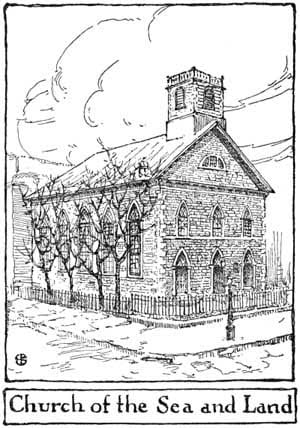This Day in Presbyterian History:
A Famous Hymn for Sailors
![Edward Hopper [17 February 1818 - 23 April 1888]](https://thisday.pcahistory.org/wp-content/uploads/2012/02/HopperEdward.jpg) The Presbyterian pastor was asked to compose a hymn verse for the anniversary of the Seamen’s Friend’s Society meeting. Instead, he brought the verse for a hymn which he had anonymously written eight years before, which was “Jesus, Savior, Pilot Me.” And so his secret was revealed to the Christian public at last.
The Presbyterian pastor was asked to compose a hymn verse for the anniversary of the Seamen’s Friend’s Society meeting. Instead, he brought the verse for a hymn which he had anonymously written eight years before, which was “Jesus, Savior, Pilot Me.” And so his secret was revealed to the Christian public at last.
Edward Hopper was born on February 17, 1816 in New York City. The son of a merchant and a mother who descended from French Calvinist Huguenots, he ministered all his life, except for twelve years elsewhere, in New York City. After graduating from New York University (1839) and Union Theological Seminary (1842), he became the pastor of the Church of the Sea and Land, a church for sailors. He would remain there all his life and die in 1888.
 Consider the words of this famous hymn which was a perfect application for those who made their living on the sea or those in military service on the sea. In fact, you are invited to sing it or hum it for your loved ones and friends who may be this very day on the sea.
Consider the words of this famous hymn which was a perfect application for those who made their living on the sea or those in military service on the sea. In fact, you are invited to sing it or hum it for your loved ones and friends who may be this very day on the sea.
“Jesus, Savior, pilot me”
Jesus, Savior, pilot me Over life’s tempestuous sea;
Unknown waves before me roll, Hiding rock and treach-‘rous shoal;
Chart and compass came from thee: Jesus, Savior, pilot me.
As a mother stills her child, Thou canst hush the ocean wild;
Bois-t’rous waves obey thy will When thou sayest to them, “Be still.”
Wondrous Sovereign of the sea, Jesus, Savior, pilot me.
When at last I near the shore, And the fearful breakers roar
‘Twixt me and the peaceful rest, Then, while leaning on thy breast,
May I hear thee say to me, “Fear not, I will pilot thee.” Amen.
[ Click the link to hear the hymn sung: Jesus, Savior, pilot me. ]
Hopper would write three more verses of this hymn, comprising the second, third, and fourth verses, though these additional verses did not become part of the final version that appeared in most church hymnals. What was published rang true, even for the non-sailor, with its comparison of life with the stormy sea, filled with dangers and temptations. Jesus is described as the Pilot who guides godly men and women through that stormy sea. The whole concept of the hymn comes from Matthew’s gospel, chapter 8, verses 23 – 27 where we have the occasion of Jesus calming the Sea of Galilee on behalf of his terrified disciples.
The last verse, which is in the form of a prayer, was uttered and answered in the life of Edward Hopper. On April 22, 1888, the text of his sermon had been “Watch, therefore, for ye know neither the day nor the hour wherein the Son of man cometh.” The next day at noon as his niece came to call him for lunch, she discovered him sitting in his chair in his study, slumped over from an apparent heart attack, with pen still in hand, for he had been working on a verse entitled “Heaven.”
Words to Live By: Live this day in dependence on Jesus Christ and Him crucified, risen, and coming again. It is only when we live in this way, that we will be ready to persevere through life, and be content in death.
Through the Scriptures: Numbers 1 – 3
Through the Standards: Sin, as discussed in the Catechisms —
WLC 21 “Did man continue in that estate wherein God at first created him?
A. Our first parents being left to the freedom of their own will, through the temptation of Satan, transgressed the commandment of God in eating the forbidden fruit; and thereby fell from the estate of innocency wherein they were created.”
WSC 13 “Did our first parents continue in the estate wherein they were created?
A. Our first parents, being left to the freedom of their own will, fell from the estate wherein they were created, by sinning against God.”
Image sources: The Kirk on Rutgers Farm. New York: Fleming H. Revell, 1919. Pages 56 and title page, respectively. Note: We will take this book as authoritative in the spelling of Rev. Hopper’s name, though there are sources that can be found with the spelling of “Hooper”.
For further study: The records of the American Seamen’s Friend Society are preserved at the G. W. Blunt White Library, Mystic Seaport, Mystic, CT. To view the finding aid for this collection, click here.

No comments
Comments feed for this article